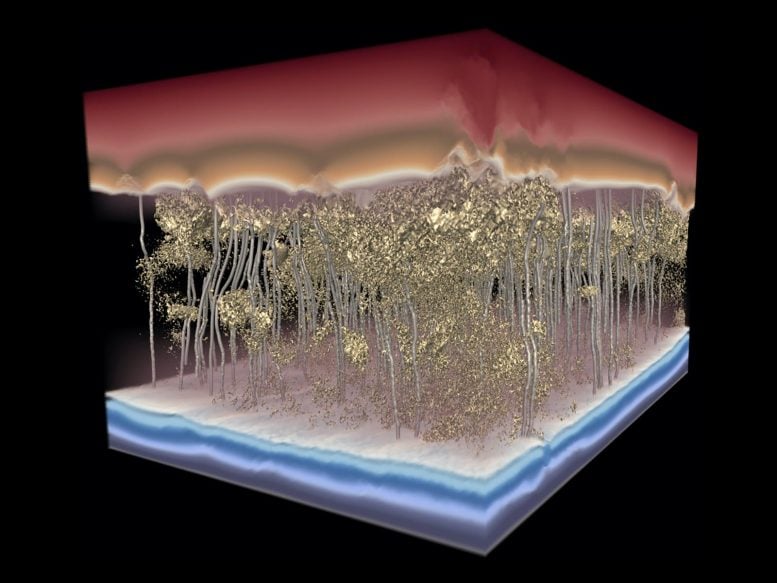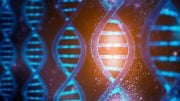
This 3D model of a polymer desalination membrane shows water flow — the silver channels, moving from top to bottom — avoiding dense spots in the membrane and slowing flow. Credit: Image by the Ganapathysubramanian research group/Iowa State University and Gregory Foss/Texas Advanced Computing Center
A desalination membrane acts as a filter for salty water: push the water through the membrane, get clean water suitable for agriculture, energy production and even drinking. The process seems simple enough, but it contains complex intricacies that have baffled scientists for decades — until now.
Researchers from Penn State, The University of Texas at Austin, Iowa State University, Dow Chemical Company, and DuPont Water Solutions published a key finding in understanding how membranes actually filter minerals from water, online today (December 31) in Science. The article will be featured on the print edition’s cover, to be issued tomorrow (January 1).
“Despite their use for many years, there is much we don’t know about how water filtration membranes work,” said Enrique Gomez, professor of chemical engineering and materials science and engineering at Penn State, who led the research. “We found that how you control the density distribution of the membrane itself at the nanoscale is really important for water-production performance.”
Co-led by Manish Kumar, associate professor in the Department of Civil, Architectural and Environmental Engineering at UT Austin, the team used multimodal electron microscopy, which combines the atomic-scale detailed imaging with techniques that reveal chemical composition, to determine that desalination membranes are inconsistent in density and mass. The researchers mapped the density variations in polymer film in three dimensions with a spatial resolution of approximately one nanometer — that’s less than half the diameter of a DNA strand. According to Gomez, this technological advancement was key in understanding the role of density in membranes.
“You can see how some places are more or less dense in a coffee filter just by your eye,” Gomez said. “In filtration membranes, it looks even, but it’s not at the nanoscale, and how you control that mass distribution is really important for water-filtration performance.”
This was a surprise, Gomez and Kumar said, as it was previously thought that the thicker the membrane, the less water production. Filmtec, now a part of DuPont Water Solutions, which makes numerous desalination products, partnered with the researchers and funded the project because their in-house scientists found that thicker membranes were actually proving to be more permeable.
The researchers found that the thickness does not matter as much as avoiding highly dense nanoscale regions, or “dead zones.” In a sense, a more consistent density throughout the membrane is more important than thickness for maximizing water production, according to Gomez.
This understanding could increase membrane efficiency by 30% to 40%, according to the researchers, resulting in more water filtered with less energy — a potential cost-saving update to current desalination processes.
“Reverse osmosis membranes are so widely used for cleaning water, but there’s still a lot we don’t know about them,” Kumar said. “We couldn’t really say how water moves through them, so all the improvements over the last 40 years have essentially been done in the dark.”
Reverse osmosis membranes work by applying pressure on one side. The minerals stay there, while the water passes through. While more efficient than non-membrane desalination processes, this still takes an immense amount of energy, the researchers said, but improving the efficiency of the membranes could reduce that burden.
“Freshwater management is becoming a crucial challenge throughout the world,” Gomez said. “Shortages, droughts — with increasing severe weather patterns, it is expected this problem will become even more significant. It’s critically important to have clean water available, especially in low resource areas.”
The team continues to study the structure of the membranes, as well as the chemical reactions involved in the desalination process. They are also examining how to develop the best membranes for specific materials, such as sustainable yet tough membranes that can prevent the formation of bacterial growth.
“We’re continuing to push our techniques with more high-performance materials with the goal of elucidating the crucial factors of efficient filtration,” Gomez said.
More on this research:
- Desalination Breakthrough Maximizes Flow for Cheaper Water Filtration
- Nanoscale Control of Desalination Membranes Could Lead to Cheaper Water Filtration
Reference: “Nanoscale control of internal inhomogeneity enhances water transport in desalination membranes” by Tyler E. Culp, Biswajit Khara, Kaitlyn P. Brickey, Michael Geitner, Tawanda J. Zimudzi, Jeffrey D. Wilbur, Steven D. Jons, Abhishek Roy, Mou Paul, Baskar Ganapathysubramanian, Andrew L. Zydney, Manish Kumar and Enrique D. Gomez, 31 December 2020, Science.
DOI: 10.1126/science.abb8518
Other contributors include first author Tyler E. Culp, Kaitlyn P. Brickey, Michael Geitner, and Andrew Zydney, all of whom are affiliated with the Penn State Department of Chemical Engineering; Biswajit Khara and Baskar Ganapathysubramanian, both with the Department of Mechanical Engineering at Iowa State University; Tawanda J. Zimudzi of the Materials Research Institute (MRI) at Penn State; Jeffrey D. Wilbur and Steve Jons, both with DuPont Water Solutions; and Abhishek Roy and Mou Paul, both with Dow Chemical Company. Gomez is also affiliated with MRI. The microscopic work was conducted on electron microscopes in the Materials Characterization Lab in MRI. DuPont and the National Science Foundation funded the research.









couldnt we use gravity to force water thru membranes ???
Very Good.
Congratulations on making progress.
Sharing some thoughts and suggestions for consideration of the larger Scientific Community. Views expressed are personal and may be thought to be Pie in the sky as these were rejected and laughed at when I submitted these as my inputs for the National Science Talent Search Committee in the early 1970’s after I graduated from High School in India.
Many of these ideas are still not implemented. Anyway, no harm in sharing my thoughts and expressing my opinion about this subject.
Opinions expressed and Views are not binding on others.
Q. What is the Difference between Fresh Water and Sea Water.
Ans. Fresh water is Salt Free and Sea Water is Salty. Salt is Sodium Chloride . NaCl. In Water these exist as Na+ Ions and Cl- Ions.
Ocourse Sea Water has other Other Dissolved metals and minerals . So once we eliminate Na+ Ions and Cl- Ions we will have mineral water! Now the Mineral Water can be made into drinking water aligned with the water requirements of the human, mammal and other creatures in line with their requirements for good health. Doctors and Veteranarins can help determine such needs. The Minimum daily trace metal requirements for humans are known. Excess metals and minerals can be removed using Reverse Osmosis technology using different levels of Pressure to get water with appropriate mineral content aligned with the need of the consumer! Water made to order as medicine!
Now this Mineral Water (after N+ & Cl- removal) can be made soil friendly depending on the soil , its fertility, mineral content etc. and also the crops to be grown on that soil. Crops can be rotated to make the soil perpetually ever-fertile and stop the desetification creep which is going on globally.
Now this mineral water from the Oceans after Salt Removal (NaCl) , can be embedded with both Nirogenous and Phosphatic Fertilizers as required to get maximum yield of the crops to be grown. Such nutritious de-salted mineral water with added fertilizer can be delivered directly to the roots usng micro irrigation Technology which has been mastered in the deserts of the middle east by Israel (God-bless them) and is the first nation to have its population 100% innoculated against C-19. Well done.
The complaint about huge amounts of energy requirements for Reverse Osmosis requirement is a no brainer to fix. There are multiple ways. Use Solar Energy with improved efficiency to convert the suns rays to drive the energy necessary. Another way is understanding the components of Sea Water. Sea Water Contains an unlimited supply of H2O, H3O (Deuterium), and H3O(Tritium) i.e. Heavy Water used in Nucllear Reactors.
Make the world a little better. Not too much. Just a little better!
100% efficiency is very much possile for all the suggested type of Nano embedded Membranes.
Now that the fresh water Issue is seeing Light at the end of the tunnel, How about fixing the Fresh Air problem. Let us work on fixing that using Science rather than by Fiat to Oil Producing Companies and Coal Producng Companies. Make other Sources ofEnergy much much cheaper than burning the remains of dead ancient creatures.
These Fossil Fuels are too valuable to be burnt to get heat in cold climates. Burning the remains of ancient Dinosaurs may be downright stupid. Burning Coal — Remains of Ancient DEAD Trees may be even more Stupid. It could have much better use and value in the futre which we dont know yet.
I Repaet — Views expressed are personal and not binding on anyone.
Leaving on an island in the Pacific ocean and water is a major problem for my island people,if it’s already available,how can we Access it. Would you be able to provide details.